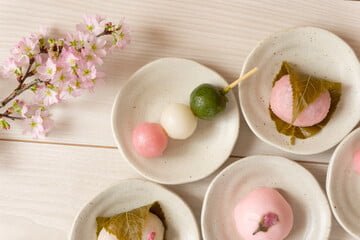The Art of Enjoying Wagashi: Essential Etiquette for Japanese Sweets and Desserts
Wagashi, traditional Japanese sweets, are not merely confections but also works of art that express Japanese culture and seasonality. To fully appreciate their beauty and taste, it’s important to understand the proper way to enjoy them. In this article, we’ll explore the etiquette and tips for maximizing your wagashi experience.
Preparing to Savor Wagashi: Engaging Your Senses
Appreciate the Seasons Wagashi often represent seasonal themes. Take note of seasonal ingredients and designs. Notice the Presentation Pay attention to the dish and surrounding environment, which enhance the wagashi’s appeal. And appreciate the Craftsmanship Wagashi embody the skill and passion of their creators. Reflecting on this can deepen your appreciation.
1. Before Tasting Wagashi
1.1 Appreciate the Appearance Wagashi’s visual appeal is an essential aspect. Before eating, take a moment to admire the shape, color, and seasonal design.
1.2 Enjoy the Aroma Gently bring the wagashi close to your nose and inhale its fragrance. The scent of cherry blossom leaves in sakura mochi or the aroma of matcha in green tea sweets are part of the wagashi charm.
2. Basic Wagashi Eating Etiquette
2.1 Use Your Hands or a Pick Most wagashi can be eaten directly with clean hands. However, for sticky or delicate sweets, use the provided pick or cake cutter.
2.2 Take Appropriate Bites It’s polite to eat wagashi in bite-sized pieces, especially in formal settings like tea ceremonies.
2.3 Savor Slowly Wagashi have subtle flavors. Take your time to enjoy them, allowing the taste to develop in your mouth.
3. Enjoying Wagashi with Tea
3.1 Wagashi First, Then Tea Generally, eat the wagashi before drinking tea. The sweetness of the wagashi complements the bitterness of the tea.
3.2 Tea Ceremony Etiquette In tea ceremonies, use the provided kaishi paper or wagashi pick. After use, fold them neatly and place them in front of your knees.
How to Eat Different Types of Wagashi
Nerikiri
These beautifully crafted sweets should be eaten using a pick or small fork. Avoid touching them directly to prevent melting or deformation. Enjoy them in small bites to appreciate their delicate flavors and artistry.
Yokan
For solid yokan, use a yokan cutter or pick to slice 1-2cm pieces. For mizu yokan (summer variety), use the provided spoon. Avoid touching yokan directly to prevent stickiness or fingerprints.
Daifuku and Manju
Generally eaten by hand in 2-3 bites. In formal settings, use a small plate and pick. Be gentle to prevent the filling from bursting out, and avoid getting powder or bean paste around your mouth.
Dorayaki and Monaka
Hold these with your hands and eat from the edge. For monaka, eat the edges first, working your way to the center to prevent crumbling. Be careful not to squeeze out the filling.
Chakin Shibori
Use a pick or fork, starting from the top knot. Eat slowly, enjoying the unique shape. Remember that the wrapping is edible, despite its cloth-like appearance.
Namagashi (mainly summer varieties)
Appreciate their cool appearance before eating with a provided spoon or pick. Let them melt slowly in your mouth. Eat promptly as they can melt quickly.
Higashi (like Rakugan)
Can be eaten by hand, but use a wagashi pick in formal settings. Let them dissolve slowly in your mouth to enjoy their unique texture and flavor.
Leaf-Wrapped Wagashi (Kashiwa Mochi, Sakura Mochi)
Whether to eat the leaf is a matter of personal preference. The oak leaf of kashiwa mochi is usually not eaten, while the cherry blossom leaf of sakura mochi is edible. Enjoy the aroma of the leaves as you savor the mochi and bean paste inside. In formal settings, observe others for guidance.
Conclusion:
When enjoying wagashi, engage all your senses – sight, smell, taste, and texture. While being mindful of proper manners, don’t be too rigid. Allow yourself to fully experience the charm of wagashi. Through these sweets, you can appreciate Japan’s seasons, culture, and the artistry of skilled confectioners. Itadakimasu!

[…] > more details […]